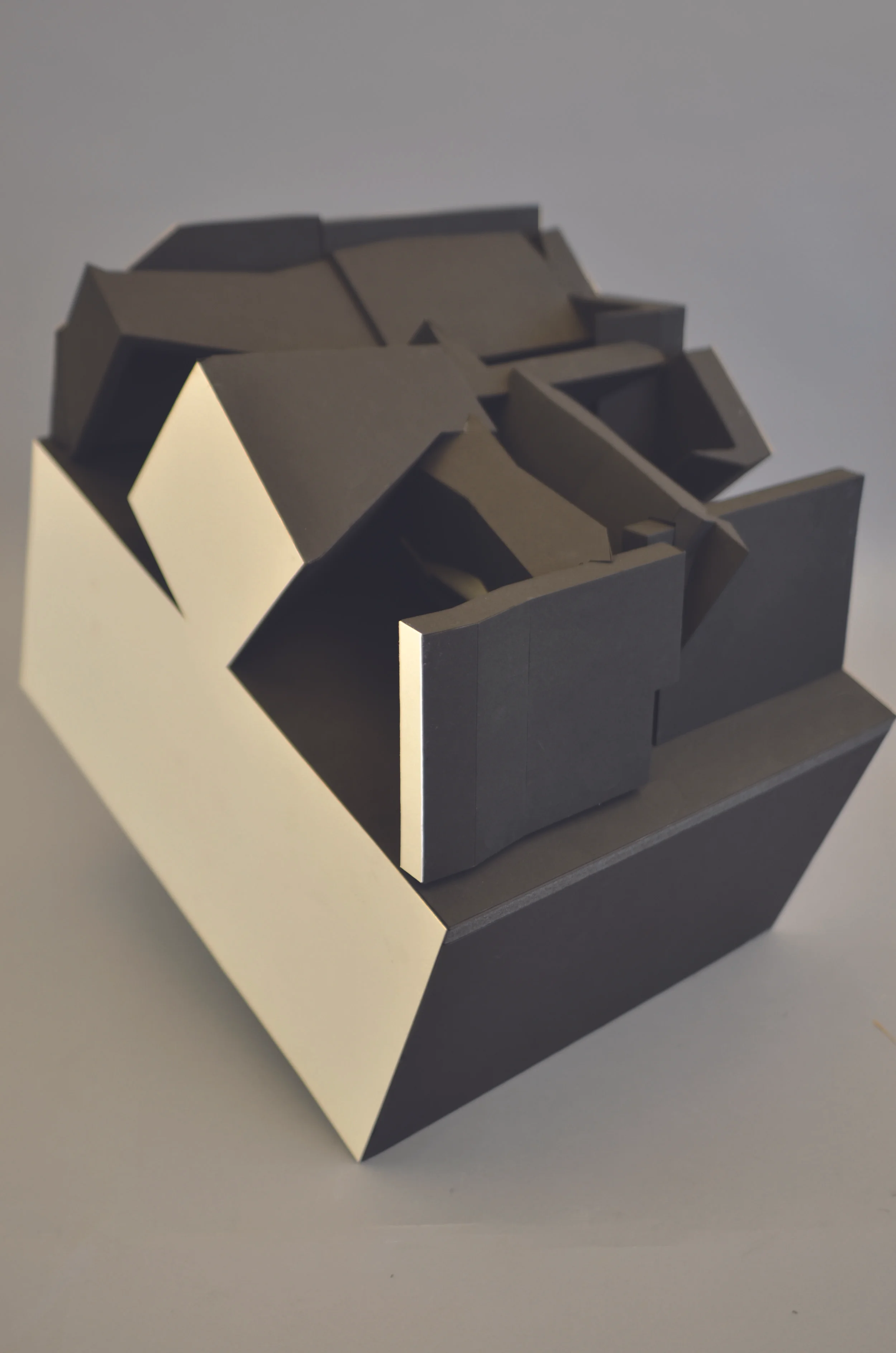Boyle Heights Bank
SCI_Arc Design Studio / Fall 13'
Instructor : Anna Neimark
Geometry, Matter, Space. Prelude
This project began with a simple exercise exploring polyhedral packing to form objects in space that operate as line and figure simultaneously. Using strictly regular octahedrons and tetrahedrons, we investigated combinatorial potentials by connecting faces of the polyhedrons to form figured lines in space. A minimum of six regular octahedrons and six regular tetrahedrons, made of folded white paper and clear scotch tape with edges each measuring one inch, were attached to one another to form figured lines in space in five different configurations.
The second exercise of this studio tasked us with engaging a large scale sculpture that embodies geometrical strategies for the instantiation of matter and space as a contemporary basis for the production of architecture. I chose to research the sculpture SMOG by Tony Smith. Smith creates large-scale installations using tetrahedrons and octahedrons; his sculpture SMOG measures 78 feet wide and 64 feet in length, using modular tetrahedrons that repeats along its length and width. The modular nodes connect to each other using stretched tetrahedrons, forming a grid. This deployment of volume through polyhedral packing, elongation, and connection forms a lattice that hovers between object and field. The wide range of possible outcomes suggested by Smith’s various works SMOKE, SMUG, and SMOG suggest a language of possible variables that can change: types of polyhedrons (tetra-, octa-, stretched octa-), number of polyhedrons, scale of polyhedrons (length of normal edge, length of stretched edge), and relationships of polyhedrons to each other. The challenge was to develop a procedure for expanding and transforming this precedent while working only with the variables Smith used.
In this way, we were inheriting from the Baroque’s innovations of transformation in architecture: while Bernini deployed and transformed the classical orders to great theatrical effect, stretching and extending known systems (intrinsic), Guarino Guarini, following the work of Borromini, brought much more complex mathematical and geometric systems that were outside the classical origins of the movement to bear on his work. If every historic architectural movement can be understood in terms of its techniques of transformation, this project endeavours to discover a new mode of geometrical reading in architecture through the deformation and multiplication of the systems in contemporary sculpture.
In this way, we were inheriting from the Baroque’s innovations of transformation in architecture: while Bernini deployed and transformed the classical orders to great theatrical effect, stretching and extending known systems (intrinsic), Guarino Guarini, following the work of Borromini, brought much more complex mathematical and geometric systems that were outside the classical origins of the movement to bear on his work. If every historic architectural movement can be understood in terms of its techniques of transformation, this project endeavours to discover a new mode of geometrical reading in architecture through the deformation and multiplication of the systems in contemporary sculpture.
Expanding the latticework of SMOG required decisions on the direction of expansion, the rotation angle, and the degree of multiplication. In particular, the choice of center point for the rotation was crucial for radial multiplications. These decisions required a keen understanding of the growth model of the precedent. I also investigated how to terminate this expanding system, considering both intrinsic end points, such as starting and stopping the lattice at an internal point, edge, or plane, and extrinsic limits, such as introducing new cutting planes. These cutting planes revealed different sectional characteristics and potential spatial configurations. Intrinsic cuts could also be used: voiding parts of the composition from the inside created new interior views and revealed the occupancy of neighboring spaces while also enriching the reading of additional voids within the tetrahedrons’ negative space pattern. Orientation, posture, grain, and density were all important considerations in deploying these transformations. Through transforming the original geometric precedent, intrinsic aspects of its system were challenged.
The Project
The expanded field objects that resulted were then analyzed using orthographic projections and axonometric drawings, distilling the system into rich organizational diagrams. These drawings were then applied generatively to a rectangular site, filling the site completely by layering several different precedent diagrams using different starting points. By employing different three-dimensional manifestations of the diagrams and varying distributions of the patterns, a wide range of spatial concepts were explored: condensed vs. expanded, box as a program boundary vs. no boundary, enclosed stand-alone spaces vs open, interconnected spaces flowing out to the exterior.
The design of an approximately 10,000 SF single-story, local banking facility in Boyle Heights.
Drawings
Long Section
Program Diagram
Site Plan
Short Section
Plan
Worms Eye






![Axonometric [Converted]-01.png](https://images.squarespace-cdn.com/content/v1/5a7d2a36d7bdcef9f063ffc9/1520316735846-GG59WGI7RQ9KMJQ253Q3/Axonometric+%5BConverted%5D-01.png)
![Section [Converted]-01.png](https://images.squarespace-cdn.com/content/v1/5a7d2a36d7bdcef9f063ffc9/1520316749040-FIHNRA5JNLV8B5QN6YBF/Section+%5BConverted%5D-01.png)
![Plan Final [Converted]-01.png](https://images.squarespace-cdn.com/content/v1/5a7d2a36d7bdcef9f063ffc9/1520316736060-8G94MN7LGSYV1ZVQJ7F4/Plan+Final+%5BConverted%5D-01.png)






















